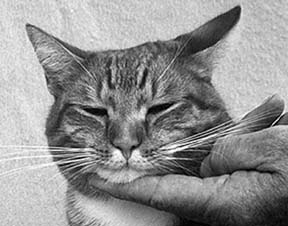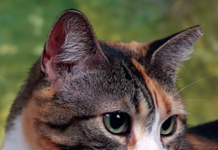
288
On any given morning, you can find Maryjean Ballner sitting on the kitchen floor with her two cats sprawled out in front of her, purring contentedly. Every morning while my coffee is brewing, I sit down and spend a few minutes massaging my two cats, says Ms. Ballner, an author and New York State licensed massage therapist.
Twenty years ago, while attending the Swedish Institute for Massage Therapy in New York City, Ms. Ballner rescued an injured, feral cat she named Mr. Gray. The cat was so frightened that he would not allow humans near him for several weeks.
As my training in human massage progressed, I noticed a difference in the way Mr. Gray interacted with me, Ms. Ballner reflects. The more I paid attention to how I petted him, the more attention he paid to me. Slowly, he started coming to me, but it wasnt until I started massaging him that he became affectionate.
Ms. Ballner is now a staunch supporter of pet massage. Her book, Cat Massage: A Whiskers-to-Tail Guide to Your Cats Ultimate Petting Experience, and accompanying video, Your Cat Wants a Massage, teaches people simple techniques for massaging their own cats at home.
While massage for pets is a relatively new concept, massage for people has been around for centuries. Its healing effects in humans are well-documented, for everything from the relief of pain and to easing tension to faster recovery from injury. And, like Ms. Ballner, thousands of animal lovers have discovered the benefits of massaging their companion animals.
Most people already perform some sort of massage technique when they pet their cats. In as little as four minutes a day, you can give your cat a wonderfully relaxing massage. Ms. Ballner offers the following simple massage techniques:
Go slow-mo(tion) – To get a feel for what slow-mo is, stroke your cat once down the length of his body from the top of his head to the base of his tail. Count how many seconds it takes to do that stroke. Then, repeat that stroke, doubling the time. For instance, if it took you four seconds to do the first stroke, take eight seconds to do the second one.
Caress under the chin and cheeks – Using your finger pads, move your fingers in a circular motion. Next, stroke your cat from the tip of his chin down the length of his throat. This is called chin-ups. The chinny-chin-chin technique is accomplished by rubbing tiny circles at the tip of the chin.
Repeat, repeat, repeat – Its not necessary to learn every single technique. Just choose two or three easy strokes and repeat them several times. Humans are busy by nature; were always multi-tasking, Ms. Ballner says. Cats dont multi-task – theyre very content with very slow strokes.
For the past five years, Ms. Ballner has volunteered at the Peninsula Humane Society in San Mateo, California. Because the environment in a shelter can be very stressful for the cats awaiting adoption, she uses cat massage to help alleviate some of their anxiety.
For frightened or aloof cats, I use a long-handled bath brush available at any drug store, Ms. Ballner explains. This allows me to have a connection without contact. Its the first step to getting closer to the animal. Massage helps to make the cats calmer and more social and, therefore, more adoptable.
Massage is a fantastic way to express love for our cats, Ms. Ballner concludes. Fancy food bowls and cute collars are nice, but what your cat really wants is affection and attention. Since we humans dont speak fluent meow, the best way we can communicate with our cats is through touch. And the best touch is massage.
For more information about Maryjean Ballners book and video on Cat Massage, you can call 877-MEOW-MEOW or visit www.catmassage.com/.



